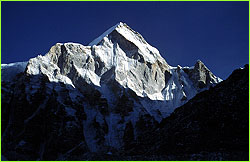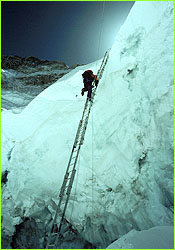
|
 |
 |
 Climbing without O's
Climbing without O'sby John B. West, M.D., Ph.D. The successful ascent of Everest without supplementary oxygen is one of the great sagas of the 20th century. In addition to being a triumph of the human spirit, it raises some of the most intriguing questions in human physiology. Ever since I was invited by Sir Edmund Hillary to take part in the Himalayan Scientific and Mountaineering Expedition of 1960-1961 I have had a special interest in the critical factors that allow climbers to reach extreme altitudes—particularly the summit of Everest—without supplementary oxygen. Back in 1960, Messner and Habeler had yet  to make their ascent of Everest without supplemental oxygen,
and many believed that it was physiologically impossible.
to make their ascent of Everest without supplemental oxygen,
and many believed that it was physiologically impossible.Over the course of our scientific expedition more than three decades ago, a group of physiologists spent about five months at an altitude of 5800 m (19,000 ft) on a glacier about 10 miles south of Mt. Everest. We lived in a prefabricated hut known as the "Silver Hut" because of its color. The scientific leader was Dr. Griffith Pugh and we made an extensive study of the process of acclimatization to this very high altitude. In the spring, we were joined by a climbing party who attempted (unsuccessfully) to reach the summit of Makalu (8481 m) without supplementary oxygen. A bicycle ergometer (which measures the amount of work done by the exercising subject) was assembled on the Makalu Col just east of Everest and we made measurements of maximal work capacity at an altitude of 7440 m (24,400 ft). These remain the highest measurements of work capacity ever made on a mountain. When the line relating maximal oxygen consumption to altitude was extrapolated all the way to the summit of Mt. Everest, it looked as though the mountain could not be climbed without supplementary oxygen. The same conclusion had been reached by other physiologists in the 1930s. Therefore when Messner and Habeler finally made their "oxygenless" ascent in 1978, we naturally wondered how they did it. When we planned the 1981 American Medical Research Expedition to Everest, we ambitiously decided to try to make a few measurements on the summit to try to answer that question. We identified three critical measurements. The first was the atmospheric pressure, because it was clear that the amount of work that a climber could do was extremely sensitive to this; atmospheric pressure determines how much oxygen is in the air, and the lower the pressure, the lower the amount of oxygen. Furthermore, some physiologists had previously predicted the pressure on the summit from the so-called Standard Atmosphere and we knew that this was far too low based on measurements made at lower altitudes on Everest. In any case, the first direct measurement of atmospheric pressure on the summit was made on our expedition by Dr. Christopher Pizzo, and the figure of 253 mmHg was rather higher than even we expected—suggesting that there was more oxygen at the summit of Everest than you would predict from theory.  This year, David Breashears was able to take another
measurement on the summit. As soon as we are able to check the
calibration of the instrument we will know more about this
critically important variable—and therefore have a
better sense of how much oxygen is actually available at the
tallest point on earth.
This year, David Breashears was able to take another
measurement on the summit. As soon as we are able to check the
calibration of the instrument we will know more about this
critically important variable—and therefore have a
better sense of how much oxygen is actually available at the
tallest point on earth. The second critical variable was the extent to which the climbers increased their ventilation, because this process maintains the oxygen level in the alveoli in the depths of the lung at a viable level. Pizzo measured his ventilation by taking samples of air from the depths of his lung while sitting on the Everest summit. The results showed that he had increased his ventilation about five to six-fold, which was much more than we expected. The third critical measurement was the maximal oxygen consumption on the summit. Previous predictions were that this was insufficient for a climber to reach the summit without supplementary oxygen. It was not possible to put a bicycle ergometer on the top of Mt. Everest; there is a limit to what can be done in the field! However we had extremely well-acclimatized climbers breathe 14% oxygen (normal air has 21%) in our laboratory at 6300 m (21,000 ft). The low inspired oxygen mixture gave them the same oxygen pressure as on the Everest summit. We found that the maximal oxygen consumption was about one liter per minute. This is a miserable value, equivalent to that of someone walking slowly on level ground. However it is just sufficient to allow a climber to reach the summit without supplementary oxygen. A simulated climb of Everest carried out in a low-pressure chamber four years later (Operation Everest II) found almost exactly the same maximal oxygen consumption. Although we now have a much clearer idea of how a climber can make an "oxygenless" ascent of Mt. Everest, a number of areas of ignorance remain. One is the degree to which the blood becomes alkaline as a result of the extreme increase in ventilation. Pizzo's measurements suggested a very severe degree of alkalinity which interestingly enough helps  to load oxygen onto the blood in the lung. However some people
have challenged this finding and we badly need more data.
to load oxygen onto the blood in the lung. However some people
have challenged this finding and we badly need more data.
Another area of ignorance is whether the body produces lactate—a normal byproduct of exercise—under these conditions of extreme oxygen deprivation. Making lactate allows the muscles to do work in the absence of oxygen. Exercising muscles normally produce large amounts of lactate when they are starved of oxygen. Paradoxically, this does not seem to be the case in acclimatized people at extreme altitude. Indeed, predictions based on measurements at somewhat lower altitudes suggest that no lactate at all is produced near the summit of Mt. Everest.  John West
is Professor of Medicine and Physiology in the School of
Medicine, University of California San Diego. He was a
physiologist on Sir Edmund Hillary's Silver Hut expedition
in 1960-1961, and led the 1981 American Medical Research
Expedition to Everest.
John West
is Professor of Medicine and Physiology in the School of
Medicine, University of California San Diego. He was a
physiologist on Sir Edmund Hillary's Silver Hut expedition
in 1960-1961, and led the 1981 American Medical Research
Expedition to Everest.Photos: (1,2) Liesl Clark; (3) David Breashears; (4) Ed Viesturs; (5) J. West. Lost on Everest | High Exposure | Climb | History & Culture | Earth, Wind, & Ice E-mail | Previous Expeditions | Resources | Site Map | Everest Home Editor's Picks | Previous Sites | Join Us/E-mail | TV/Web Schedule About NOVA | Teachers | Site Map | Shop | Jobs | Search | To print PBS Online | NOVA Online | WGBH © | Updated November 2000 |